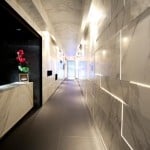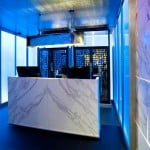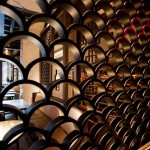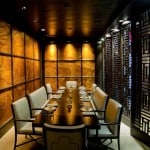In the eight short years since its creation, Trinity Building + Construction Management Corp. has roared onto the construction scene. Founded in 2005, the Massachusetts-based builder is still a relatively young company, but it has already reeled in big fish such as Wachovia and Wells Fargo in the corporate finance realm and J.Crew and Dick’s Sporting Goods in the retail arena.
But, at the very beginning, the increasingly illustrious company was simply the brainchild of three guys—Matt Kilty, Dave Story, and Paul Mancini—who became close friends while they were working for a national general contractor. “We each had a dream of owning our own business,” executive vice president Mancini says. “It struck us: We’re not getting any younger. Why not venture out and start one together? Our goal was to craft an extremely well-respected reputation.”
To explore Trinity’s focus on second-to-none service and its eagle-eye attention to detail, American Builders Quarterly caught up with senior project manager Mark Pasciuto and turned the microscope on one of the builder’s magnum opuses: Hakkasan restaurant’s American flagship location, which opened last year in New York City.

The Challenge
The very characteristic that made Hakkasan such an alluring feather in Trinity’s cap also posed the most intimidating challenges. The London-based restaurant, a top-flight take on contemporary Asian cuisine, showed in no uncertain terms that it was committed to excellence when it earned a coveted Michelin star in 2003. Anything that fell short of elite—in its design as well as in its food—wouldn’t be acceptable. The pressure was on.
Design Strategy
Hakkasan wanted to create a fusion of traditional Chinese ornamentation and contemporary minimalist chic, so the restaurant’s designer conceived an entrance that opens into a deep, clean, white corridor, which then leads into the restaurant’s caged areas, enclosed by elegant, hand-carved, wooden lattices. To capture the parent restaurant’s true flavor, builders from Trinity traveled to London to meet with the eatery’s top brass and immerse themselves in the Hakkasan experience. After sharing a meal with the owner, Trinity’s plans crystalized in a way that would have been impossible had it kept its relationship distant.

Materials
The restaurant has a number of signature leather, wood, glass, and stone accents, including the green cleft slate that covers the floor and the visually stunning Calacatta marble that extends from floor to ceiling in the entrance. For the marble, Trinity sent a specialist to Italy to handpick 5’ x 12’ slabs based on the quality of their dark veining. The specialist snapped photos and sent them back to base in Massachusetts for the go-ahead. The result was striking, the panels installed at varying depths evocative of a cool futurescape. The same marble is featured in the Ling Ling bar area, and diamond-shaped cutouts in the material form an undulating pattern, allowing a soft pink glow to shine through. “It’s a ‘wow’ factor,” Pasciuto says. “When you walk in, you’re in their world.”
The behind-the-scenes elements were just as essential, which is why the kitchen features heavy-duty stainless-steel fixtures that were designed and placed with special attention to the workflow. “It all has to work operationally, or it’s a failure,” Pasciuto says.
 Tools
Tools
The Trinity team Photoshopped the marble sections together and aligned the veining in an aesthetically pleasing manner. These images were then plugged into CAD software and converted to actionable files, and workers used a water-jet cutter to slice the marble and create the incredibly fine cutout designs.
In addition to these physical tools, though, Trinity also employed efficient, clear communication. While coordinating with Hakkasan’s London-based restaurant, the company also worked with the respected British food-service designer Alan Clayton and a front-of-the-house designer based in France. A clear understanding of everyone’s expectations and ideas became crucial so that Trinity’s team on the ground could give physical life to the dreams of the architects overseas.
“It isn’t quite a language barrier, but the simplest of things like taking centimeters to inches can be difficult; I had a conversion app on my iPhone that I used constantly,” Pasciuto says with a laugh. “When your client and architect are in the UK and your other designer is in France, coordinating all those parties together can be a challenge, but we did it.”
Winning Tips from a Young Business
Paul Mancini explains, in his own words, the strategies that make Trinity tick. (Hint: It always comes back to people.)
Be safe: Safety is paramount for reasons that go far beyond the liability of the company. The people who work for us all have families to care for—from the community of subcontractors we do business with to our employees.
Overdeliver: We wanted our company and our reputation to be all about customer service. That was the focus at our old firm, and it’s undeniable that clients are the lifeblood of your business. We like to find good guys who share our philosophies and stick with them, and the same goes for our employees.
Give back: Philanthropy is another huge factor for us, whether it’s sponsoring things like the Greater Boston Food Drive, the Rodman Ride for Kids, or Cradles to Crayons. Hurricane Sandy hit home with us especially hard because we have a lot of friends and colleagues who live on Long Island and in New Jersey. For us, it goes back to relationships, and we’re trying to do our small part to give back to the people who are hurting.
Mechanics
The finished restaurant includes a world-class sound system and a DJ booth that can transform the space into a club blasting electronica and house beats. Pasciuto, however, is especially proud of the back-end systems that allow the manager to control the restaurant’s ambient settings at the swipe of a button on his tablet. Trinity outfitted the site with proprietary boilers, its own exhaust infrastructure, and an über smart operating system that feeds remote temperature readings to a technician in England who can finesse them by single degrees.
“It’s a freestanding restaurant within a 15-story building, but it’s essentially self-sufficient, with utilities that are fed from the street,” Pasciuto says. “Usually, a restaurant would tie into the building. But in this case, we brought in our own services. They could log in from London right now, see the temperature of a unit in one part of the kitchen, and say, ‘We need to bring that down a few notches.’”

 Tools
Tools







